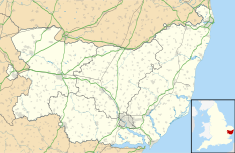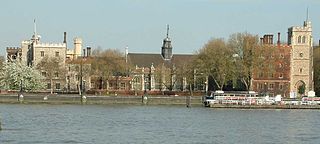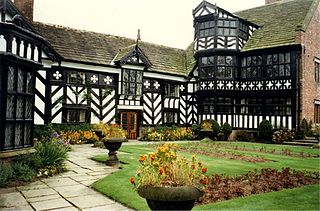
Gawsworth Old Hall is a Grade I listed country house in the village of Gawsworth, Cheshire, England. It is a timber-framed house in the Cheshire black-and-white style. The present house was built between 1480 and 1600, replacing an earlier Norman house. It was probably built as a courtyard house enclosing a quadrangle, but much of it has been demolished, leaving the house with a U-shaped plan. The present hall was owned originally by the Fitton family, and later by the Gerards, and then the Stanhopes. Since the 1930s it has been in the possession of the Richards family. Raymond Richards collected a number of items from other historic buildings and incorporated them into the hall.

Bury St Edmunds, commonly referred to locally as Bury, is a historic market and cathedral town and civil parish in Suffolk, England. The picturesque Bury St Edmunds Abbey is near the town centre. Bury is the seat of the Diocese of St Edmundsbury and Ipswich of the Church of England, with the episcopal see at St Edmundsbury Cathedral.

Donnington Castle is a ruined medieval castle, situated in the small village of Donnington, just north of the town of Newbury in the English county of Berkshire. It was founded by Sir Richard Abberbury the Elder in 1386 and was bought by Thomas Chaucer before the castle was taken under royal control during the Tudor period. During the First English Civil War the castle was held by the royalist Sir John Boys and withstood an 18-month siege; after the garrison eventually surrendered, Parliament voted to demolish Donnington Castle in 1646. Only the gatehouse survives. The site is a scheduled monument under the care of English Heritage.
This article describes the history of Suffolk, the English county.

Baconsthorpe Castle, historically known as Baconsthorpe Hall, is a ruined, fortified manor house near the village of Baconsthorpe, Norfolk, England. It was established in the 15th century on the site of a former manor hall, probably by John Heydon I and his father, William. John was an ambitious lawyer with many enemies and built a tall, fortified house, but his descendants became wealthy sheep farmers, and being less worried about attack, developed the property into a more elegant, courtyard house, complete with a nearby deer park.

The Abbey of Bury St Edmunds was once among the richest Benedictine monasteries in England, until the Dissolution of the Monasteries in 1539. It is in the town that grew up around it, Bury St Edmunds in the county of Suffolk, England. It was a centre of pilgrimage as the burial place of the Anglo-Saxon martyr-king Saint Edmund, killed by the Great Heathen Army of Danes in 869. The ruins of the abbey church and most other buildings are merely rubble cores, but two very large medieval gatehouses survive, as well as two secondary medieval churches built within the abbey complex.

Oxburgh Hall is a moated country house in Oxborough, Norfolk, England. The hall was built for Sir Edmund Bedingfeld who obtained a licence to crenellate in 1482. The Bedingfelds gained the manor of Oxborough through marriage in the early 15th century, and the family has lived at the hall since its construction, although ownership passed to the National Trust in 1952. The house underwent extensive refurbishment in the mid 19th century under John Chessell Buckler and Augustus Pugin.

Appleby Magna is a village and civil parish in the North West Leicestershire district, in the county of Leicestershire, England. It includes the small hamlets of Appleby Parva and Little Wigston.

Erwarton or Arwarton is a small village and civil parish in the Babergh district of Suffolk, England. The parish includes the hamlet of Shop Corner. Located on the Shotley peninsula around 9 miles (14 km) south of Ipswich, in 2005 it had a population of 110, increasing to 126 at the 2011 Census.
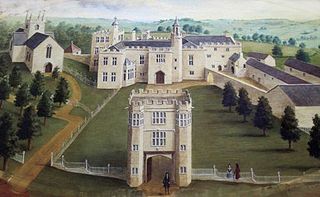
Old Shute House, located at Shute, near Colyton, Axminster, Devon, is the remnant of a mediaeval manor house with Tudor additions, under the ownership of the National Trust. It was given a Grade I listing on 14 December 1955. It is one of the most important non-fortified manor houses of the Middle Ages still in existence. It was built about 1380 as a hall house and was greatly expanded in the late 16th century and partly demolished in 1785. The original 14th-century house survives, although much altered.

Ingatestone Hall is a Grade I listed 16th-century manor house in Essex, England. It is located outside the village of Ingatestone, approximately 5 miles (8.0 km) south west of Chelmsford and 25 miles (40 km) north east of London. The house was built by Sir William Petre, and his descendants live in the house to this day. Part of the house is leased out as offices while the current Lord Petre's son and heir apparent lives in a private wing with his family. The Hall formerly housed Tudor monarchs such as Queen Elizabeth I.
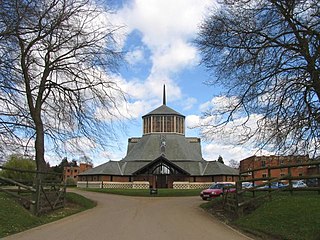
Douai Abbey is a Benedictine Abbey at Upper Woolhampton, near Thatcham, in the English county of Berkshire, situated within the Roman Catholic Diocese of Portsmouth. Monks from the monastery of St. Edmund's, in Douai, France, came to Woolhampton in 1903 when the community left France as a result of anti-clerical legislation. The abbey church is listed Grade II* on the National Heritage List for England.

Hengrave Hall is a Grade I listed Tudor manor house in Hengrave near Bury St. Edmunds in Suffolk, England and was the seat of the Kitson and Gage families 1525–1887. Both families were Roman Catholic recusants.

Cockfield Hall in Yoxford in Suffolk, England is a Grade I listed private house standing in 76 acres (31 ha) of historic parkland, partly dating from the 16th century. Cockfield Hall takes its name from the Cokefeud Family, established there at the beginning of the 14th century. It was purchased by Jon Hunt in 2014 to form part of his Wilderness Reserve offering exclusive rural holiday accommodation.

St Mary's Church is the civic church of Bury St Edmunds and is one of the largest parish churches in England. It claims to have the second longest nave, and the largest West Window of any parish church in the country. It was part of the abbey complex and originally was one of three large churches in the town.

Sir Thomas Kitson was a wealthy English merchant, Sheriff of London, and builder of Hengrave Hall in Suffolk.

Rycote is a hamlet 2.5 miles (4.0 km) southwest of Thame in Oxfordshire. The Oxfordshire Way long-distance path passes through.
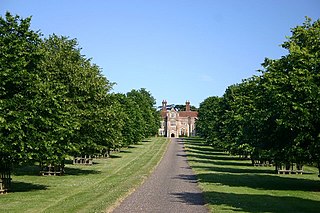
Coldham Hall is a Grade I listed building, built in 1574, that is located in the parish of Bradfield Combust with Stanningfield in Suffolk. The Hall is very close to the village of Lawshall, and part of the Coldham estate is located within this parish.

Giffords Hall is a Tudor manor house near Stoke-by-Nayland in Suffolk, England. It was described by Nikolaus Pevsner as “one of the loveliest houses of its date in England”. It is one of two houses in Suffolk formerly owned by the Gifford family in the 13th century, the other being Gifford's Hall, Wickhambrook.

